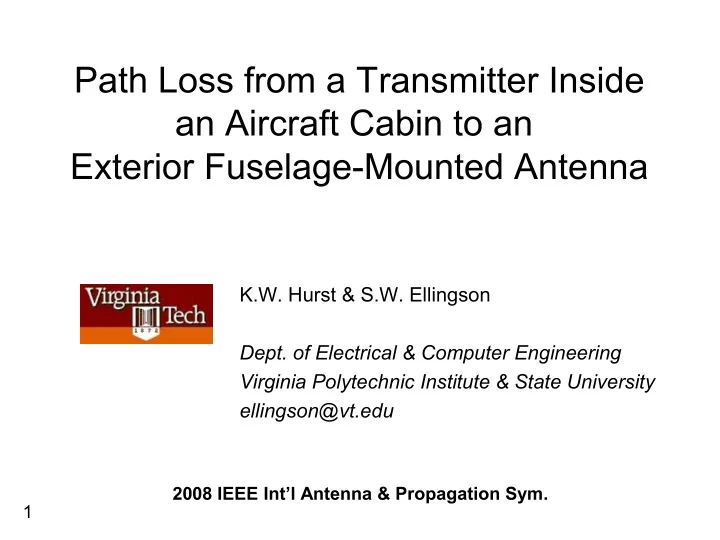

Path Loss from a Transmitter Inside an Aircraft Cabin to an Exterior Fuselage-Mounted Antenna K.W. Hurst & S.W. Ellingson Dept. of Electrical & Computer Engineering Virginia Polytechnic Institute & State University ellingson@vt.edu 2008 IEEE Int’l Antenna & Propagation Sym. 1
Introduction The increasing use of mobile electronic devices by passengers and equipment on large aircraft may increase the likelihood of interference with the aircraft's electronic systems. Thus, the ``interference path loss'' (IPL) from a transmitting device inside the cabin, to the antenna terminals of a “victim system” (such as GPS), is of interest. Full-wave and other deterministic techniques are impractical and undesirable for this purpose due to the large electrical dimensions of the aircraft, as well as the variability of the cabin configuration. We describe here an approximate approach that is not limited by computational burden and can provide additional useful insight into the problem. 2
Summary of the Method Power transmit by device in cabin Microwave cavity theory to estimate power escape through widows Replace windows with magnetic current moments radiating same power UTD to estimate power transfer from current to antenna IPL lower-bounded by sum of phase-aligned per-window contributions 3
Interior: “Power Balance Theory” (PBT) Required Parameters for PBT: V = volume of compartment S = surface area of compartment < σ a > = absorption loss cross-section < σ t > = transmission loss cross-section Number & size (but not shape) of windows Wall conductivity Adapted from D.A. Hill et al . (1994), ● IEEE Trans. on Electromagnetic Compatibility , 36, 169. Key idea: Model cabin as a lossy ● cavity. If sufficiently “reverberant”, Absorption by then power escape through windows seats & people depends only on “bulk” media and geometrical values, and is insensitive to the specific materials, positions, and orientations. 4
PBT Applied to Aircraft Cabins: GPS L1 L w is the ratio of ● power escape through windows to total power radiated by device Also shown is ● percentage of total power dissipated into people and seats Note passenger ● loading has a large effect on amount of power escaping through windows GPS L1 = 1575.42 MHz (GPS is a key system of interest in IPL studies) 5
Interior-to-Exterior Coupling Assume roughly equal ● power leaves each window (supported by measurement studies) Replace each window with ● equivalent magnetic current moments radiating the same amount of power Fuselage modeled as ● perfectly-conducting right- circular cylinder 6
Exterior: UTD Surface Diffraction Sum interference terms to determine IPL for victim antenna UTD* used to determine resulting field at antenna P.H. Pathak & Wang (1981), IEEE Trans. Ant. & Prop. , PBT predicts total power AP-29, 911. escaping window * UTD = Uniform Geometrical Theory of Diffraction 7
Single Window-to-Antenna IPL Comparison Measurement data: Jafri, Ely, & Vahala (2005), Digital Avionics Systems Conf. , 1, B.5-1. Simulation: UTD creeping wave assuming magnetic current moment equivalent to dipole placed in window Discrepency in V-pol results is unexplained, but turns out to be irrelevant when all windows are combined, as result is GPS L1 = 1575.42 MHz most accurate when IPL is (GPS is a key system of interest in IPL studies) minimum. 8
Cabin-to-Antenna IPL Comparison “o”: Simulation assumes zero passengers “x”: Simulation assumes 50% passenger load Simulation includes all windows; min IPL calculated assuming phase-aligned addition of window terms. Measurement data GPS L1 = 1575.42 MHz compiled from many sources (see journal (GPS is a key system of interest in IPL studies) paper). 9
Frequency Dependence of IPL Using B737 dimensions for an antenna located a fixed location (= position of the GPS antenna in the previous examples): a = radius of fuselage a w = radius of windows Note frequency trends: IPL increases at low frequencies because windows become electrically small IPL increases at high frequencies because creeping wave path loss increases IPL is minimum (i.e., worst case) around 1 GHz. 10
Summary This approach yields results consistent with measured results ● and provides additional physical insight that would be difficult to obtain through measurements or full-wave methods This approach is reasonable when the aircraft cabin and ● fuselage are electrically large. At VHF and below, other coupling mechanisms – e.g., coupling through wiring harnesses – dominate IPL Easily extended to deal with antennas at other locations on ● aircraft by including additional UTD diffraction terms Additional details: K.W. Hurst & S.W. Ellingson (2008), IEEE ● Trans. Electromagnetic Compatibility , in press (preprint available: http://www.ece.vt.edu/swe/) 11
Recommend
More recommend